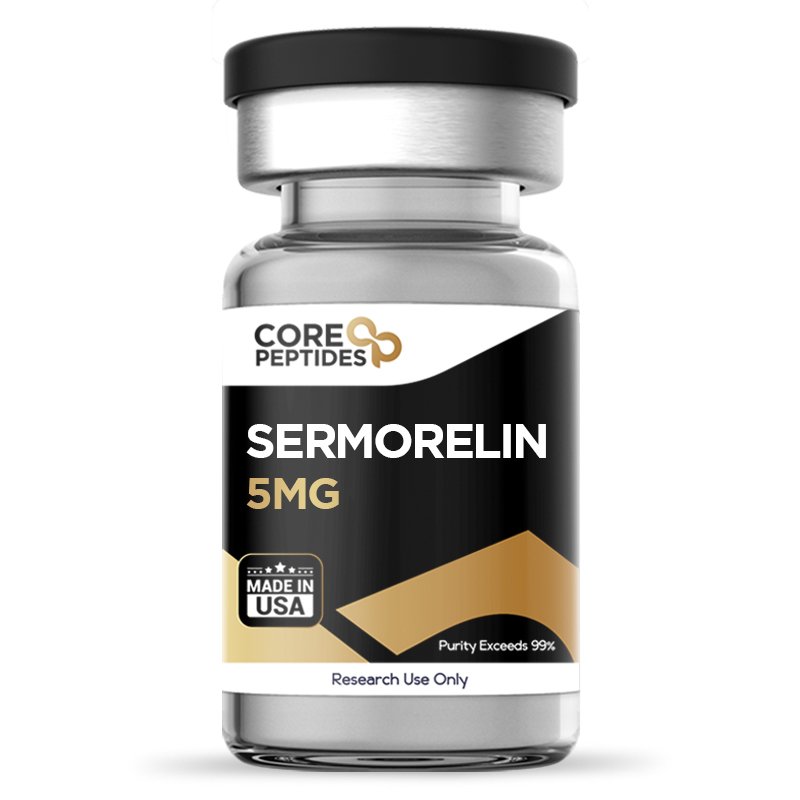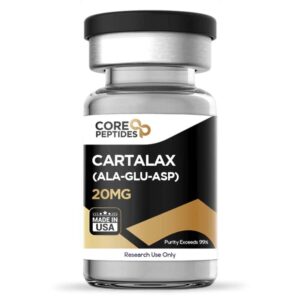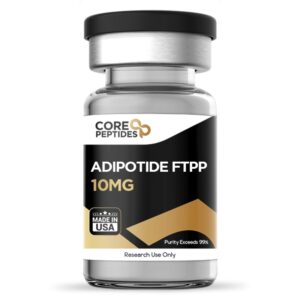Description
Sermorelin Peptide – Research Use Only | Cloud Pharmacy
Overview
Sermorelin is a synthetically engineered 29-amino acid peptide designed to replicate the biological activity of Growth Hormone-Releasing Hormone (GHRH). It represents the shortest active fragment of GHRH (1-29 amide) capable of stimulating the pituitary gland to secrete human growth hormone (hGH). Through this mimicry, Sermorelin has been widely studied in growth hormone deficiency, endocrine regulation, metabolic, and anabolic research models.
Developed in the early 1980s, Sermorelin was among the first peptides identified to effectively induce pulsatile GH secretion. Initial studies in animal models revealed that exogenous administration of GHRH (1-29) amide could activate the pituitary, enhancing growth and metabolic activity. These findings positioned Sermorelin as a foundational compound in peptide endocrinology research.
Scientific Background
Sermorelin comprises the first 29 amino acids of the natural 44-amino acid GHRH structure, yet retains full functional capability at GHRH receptor sites within the pituitary gland. This interaction triggers the release of GH into circulation, which in turn promotes hepatic and peripheral synthesis of Insulin-like Growth Factor-1 (IGF-1) — the principal mediator of growth hormone’s anabolic and metabolic effects.
The peptide’s half-life averages 11–12 minutes, ensuring transient yet potent receptor engagement. Its receptor selectivity allows for targeted GH stimulation without significantly altering other hormones such as insulin, cortisol, thyroid hormones, glucose, or prolactin. This receptor specificity makes Sermorelin a valuable subject for precision endocrine research.
Chemical Composition
-
Molecular Formula: C₁₄₉H₂₄₆N₄₄O₄₂S
-
Molecular Weight: 3357.93 g/mol
-
Chemical Name: GRF (1-29) amide
-
Synonyms: Sermorelin acetate, GHRH (1-29)
-
Classification: Growth Hormone-Releasing Hormone Analog
Mechanism of Action
Sermorelin is believed to interact directly with GHRH receptors on pituitary somatotroph cells, initiating a cascade of intracellular signaling events. Upon binding, Sermorelin likely activates adenylate cyclase, which converts ATP into cyclic adenosine monophosphate (cAMP). The resulting rise in cAMP activates Protein Kinase A (PKA), which phosphorylates downstream target proteins and promotes GH exocytosis.
Through this mechanism, Sermorelin induces endogenous GH release while preserving natural feedback control mechanisms. Elevated GH levels subsequently stimulate IGF-1 synthesis, leading to potential anabolic, metabolic, and reparative effects at the cellular level.
Research Findings
1. Sermorelin and GHRH Receptors
Molecular studies indicate that Sermorelin’s binding to GHRH receptors may structurally activate receptor domains responsible for GH secretion. The activation of the cAMP-PKA signaling pathway has been shown to result in the pulsatile release of growth hormone, similar to physiological secretion patterns observed in normal endocrine function. (12)
2. Sermorelin and Growth Velocity
In animal models of idiopathic growth hormone deficiency, researchers observed that continuous administration of Sermorelin was associated with increased growth velocity and skeletal development. The effect persisted for up to 36 months, suggesting sustained pituitary responsiveness with prolonged presence of the peptide. (7)
3. Anabolic and Metabolic Outcomes
In controlled laboratory settings, Sermorelin has been reported to enhance average GH levels by 82–107%, while raising IGF-1 by approximately 28%. Over a 16-week study period, researchers noted an increase in lean body mass (1.26 kg or 2.78 lbs), and significant improvements in skin thickness and tissue density, indicative of an anabolic response driven by elevated GH and IGF-1 levels. (13,14)
4. Lipodystrophy and Body Composition
In a 12-week, double-blind study of HIV-positive subjects with lipodystrophy, Sermorelin administration was associated with a significant increase in IGF-1 and lean body mass, alongside a decrease in visceral adiposity and trunk-to-limb fat ratio. No adverse impact was observed on glucose or insulin regulation. (8)
5. Cognitive and Neurological Research
Clinical research on adults aged 68–69 demonstrated that Sermorelin administration correlated with improved performance on the Wechsler Adult Intelligence Scale (WAIS) — specifically in verbal, picture arrangement, and problem-solving domains. Researchers propose that GH and IGF-1 upregulation may enhance neural plasticity and cognitive efficiency. (9)
6. Oncological Research
A large-scale screening of 1,018 glioma patients across more than 4,000 compound exposures revealed that Sermorelin induced notable tumor cell sensitivity. The peptide appeared to interfere with glioma cell cycle progression, suggesting potential anti-proliferative activity warranting further study. (10)
7. Hypogonadism and Endocrine Modulation
In studies involving both young and elderly male models, Sermorelin was observed to stimulate FSH and LH release, potentially influencing testosterone production. While increases in testosterone were modest and not statistically significant, GH peaks were observed predominantly during nocturnal cycles, suggesting potential normalization of circadian endocrine rhythms. (11)
Potential Research Applications
Sermorelin continues to be a focus of diverse experimental research, including:
-
Growth hormone deficiency and pituitary regulation
-
Muscle and tissue regeneration studies
-
Lipodystrophy and body composition analysis
-
Cognitive aging and neuroplasticity
-
Hormonal balance and endocrine modulation
-
Tumor biology and cellular proliferation models
Storage and Handling
-
Form: Lyophilized peptide powder
-
Purity: ≥ 98% (HPLC Verified)
-
Storage: -20°C (long-term); 2–8°C (short-term)
-
Reconstitution: Sterile water for laboratory use only
Disclaimer
Sermorelin peptide is supplied by Cloud Pharmacy for research and laboratory use only. It is not approved for human consumption, medical treatment, or veterinary use. All research must comply with applicable regulations and institutional safety protocols. Please review our Terms and Conditions before ordering.
References
-
Garcia JM, Merriam GR, Kargi AY. Growth Hormone in Aging. [Updated 2019 Oct 7]. In: Feingold KR, Anawalt B, Boyce A, et al. Endotext [Internet]. South Dartmouth (MA): MDText.com, Inc.; 2000. Link
-
Prakash, A, and K L Goa. “Sermorelin: a review of its use in the diagnosis and treatment of children with idiopathic growth hormone deficiency.” BioDrugs vol. 12,2 (1999): 139-57. PubMed
-
National Center for Biotechnology Information. “PubChem Compound Summary for CID 16129620, Sermorelin” PubChem
-
Clark, R G, and I C Robinson. “Growth induced by pulsatile infusion of an amidated fragment of human growth hormone releasing factor in normal and GHRF-deficient rats.” Nature vol. 314,6008 (1985): 281-3. PubMed
-
Drugs at FDA: FDA Approved Drugs. FDA Database
-
Junichi I. et al, Growth hormone secretagogues: history, mechanism of action, and clinical development, JSCM Rapid Communications Vol. 3 Issue 1, 09 February 2020. DOI
-
Prakash, A, and K L Goa. “Sermorelin: a review of its use in the diagnosis and treatment of children with idiopathic growth hormone deficiency.” BioDrugs (1999). PubMed
-
Koutkia, Polyxeni et al. “Growth hormone-releasing hormone in HIV-infected men with lipodystrophy: a randomized controlled trial.” JAMA vol. 292,2 (2004): 210-8. PubMed
-
Vitiello, Michael V et al. “Growth hormone releasing hormone improves the cognition of healthy older adults.” Neurobiology of Aging vol. 27,2 (2006): 318-23. PubMed
-
Chang, Yuanhao et al. “A potentially effective drug for patients with recurrent glioma: sermorelin.” Annals of Translational Medicine vol. 9,5 (2021): 406. PMC
-
Sinha, Deepankar K et al. “Beyond the androgen receptor: the role of growth hormone secretagogues in the modern management of body composition in hypogonadal males.” Translational Andrology and Urology vol. 9,Suppl 2 (2020): S149-S159. PMC
-
Zhou, F. et al. “Structural basis for activation of the growth hormone-releasing hormone receptor.” Nature Communications, 11(1), 5205 (2020). DOI
-
Vittone, J. et al. “Effects of single nightly injections of growth hormone-releasing hormone (GHRH 1-29) in healthy elderly men.” Metabolism: Clinical and Experimental, 46(1), 89–96 (1997). DOI
-
Khorram, O., Laughlin, G. A., & Yen, S. S. (1997). “Endocrine and metabolic effects of long-term administration of [Nle27]growth hormone-releasing hormone-(1-29)-NH2 in age-advanced men and women.” The Journal of Clinical Endocrinology and Metabolism, 82(5), 1472–1479. DOI





Reviews
There are no reviews yet.